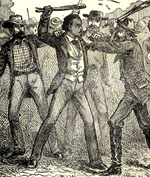Scholars in Action: Analyzing Blues Songs
Scholars in Action presents case studies that demonstrate how scholars interpret different kinds of historical evidence. "Two White Horses Standin' in Line" (sung by Smith Cason) and "Worry Blues" (sung by Jesse Lockett), both recorded in 1939 by folklorist Alan Lomax, are known as "blues" songs.
The blues emerged as a musical form among African Americans in the late 19th and early 20th centuries and gained the attention of folklorists and record companies. Historians have studied blues and other African American musical forms to gain insight into the experiences and perspectives of poor and working-class African Americans who left few written records about their lives.
